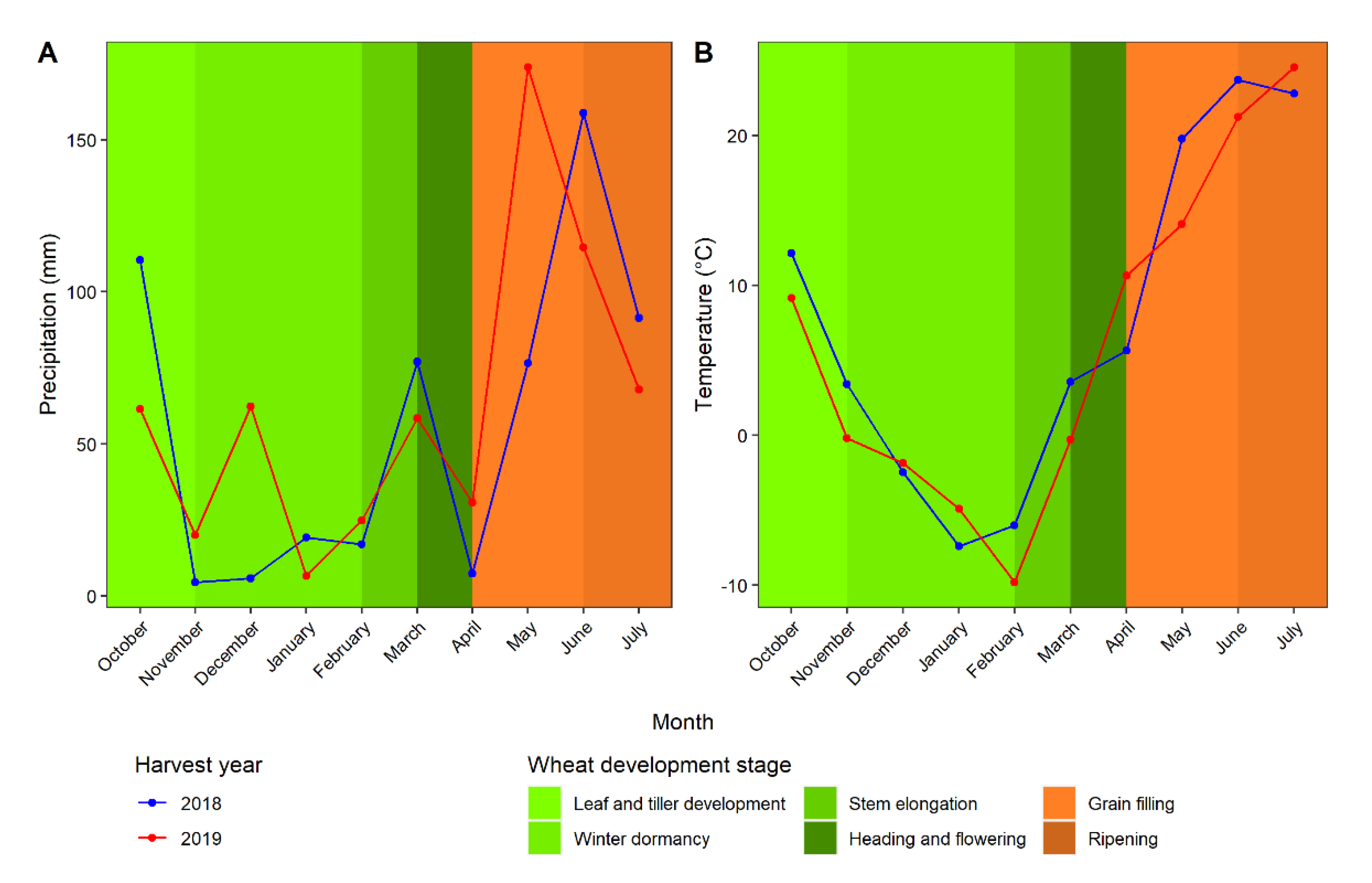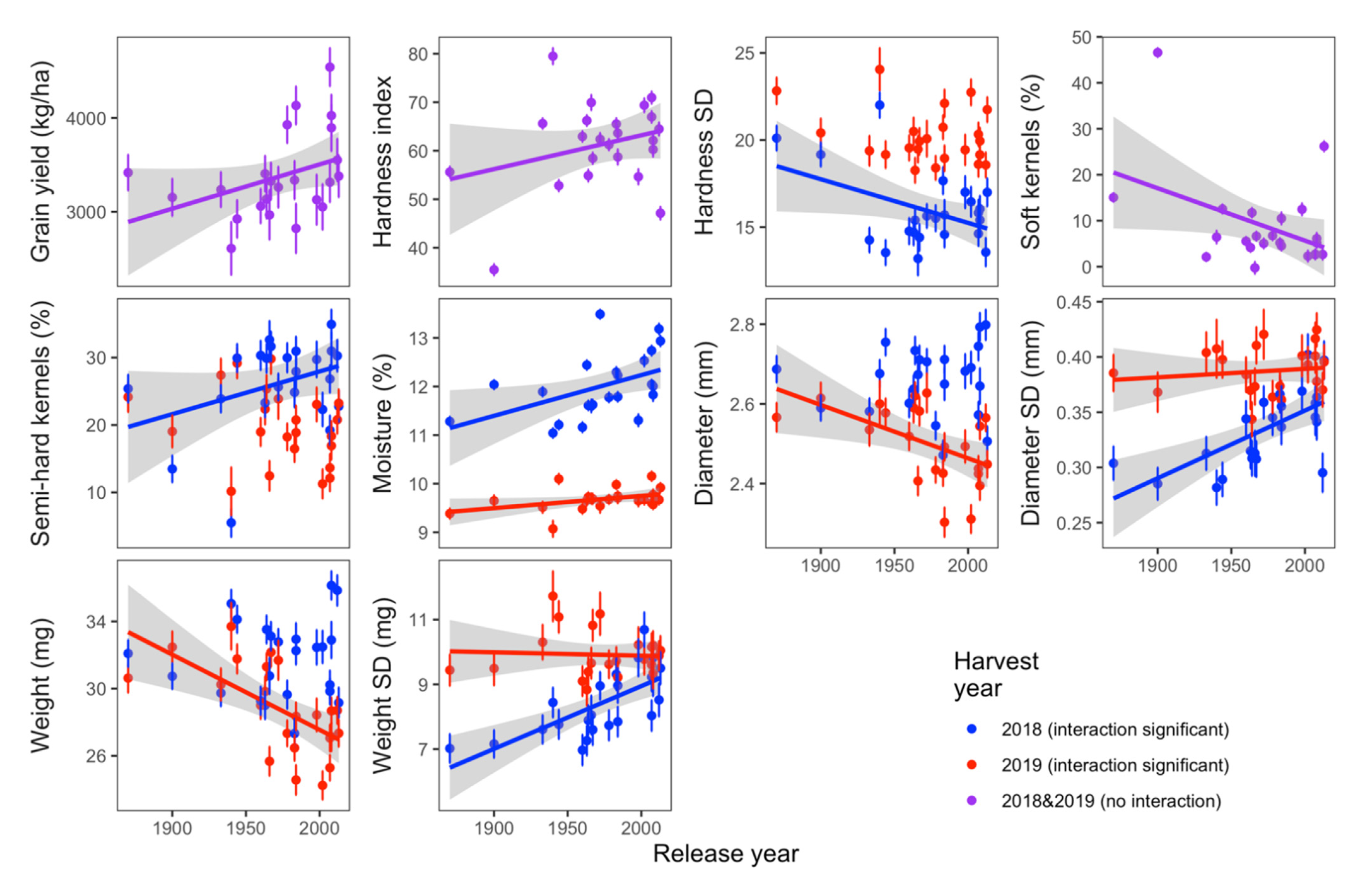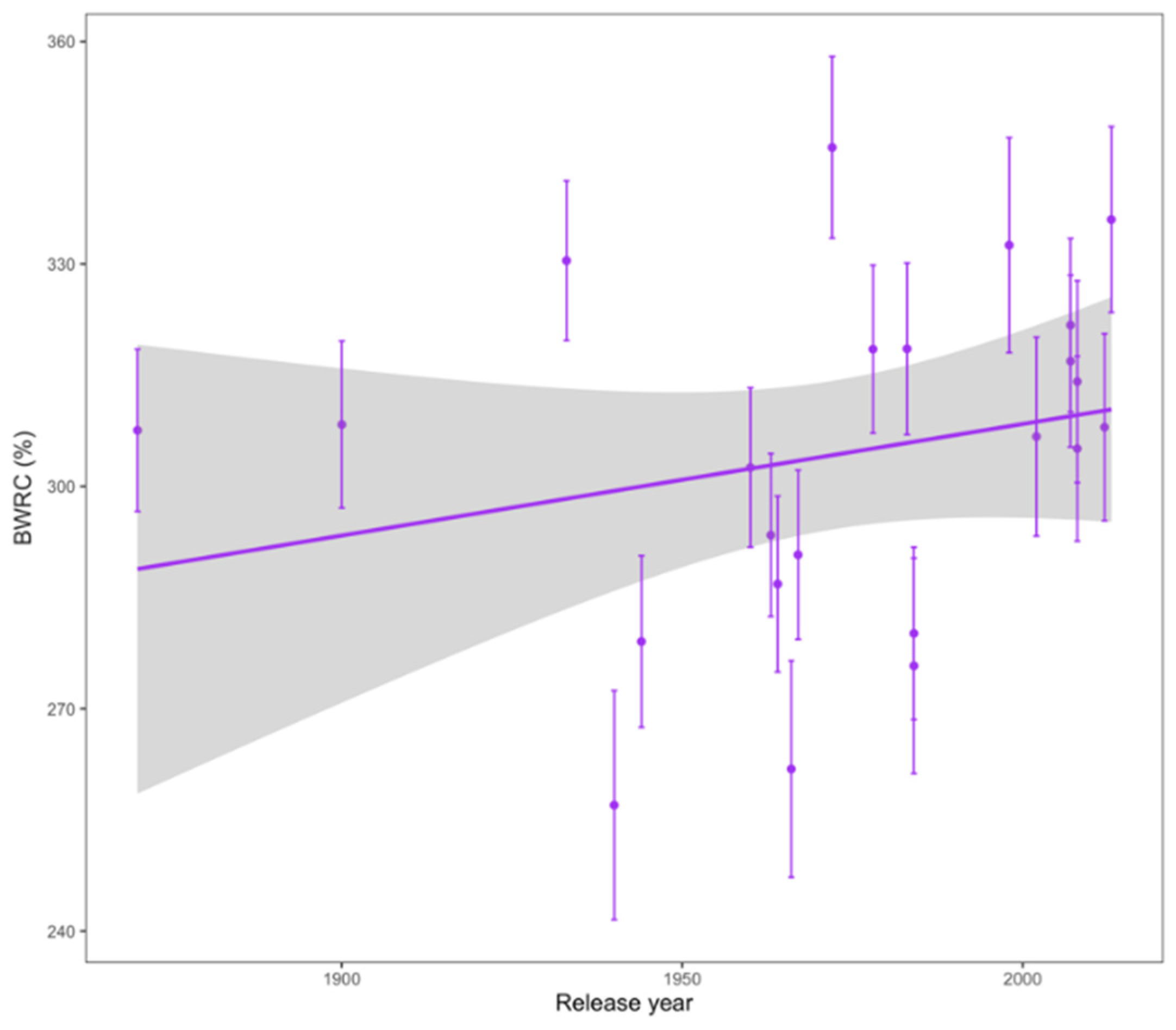End-Use Quality of Historical and Modern Winter Wheats Adapted to the Great Plains of the United States
Abstract
:1. Introduction
2. Materials and Methods
2.1. Materials
| Cultivar. | Year of Release | Place of Origin (US) | PI or CI Number | Rht-B1/Rht-D1 b |
|---|---|---|---|---|
| Turkey | 1870 | Landrace | CItr 5757 | a/a |
| Kharkof | 1900 | Landrace | PI 5641 | a/a |
| Cheyenne | 1933 | UNL | CItr 8885 | a/a |
| Red Chief | 1940 | Kansas | CItr 12109 | a/a |
| Wichita | 1944 | KSU | CItr 11952 | a/a |
| Warrior | 1960 | UNL | CItr 13190 | a/a |
| Lancer | 1963 | USDA/UNL | CItr 13547 | a/a |
| Triumph 64 | 1964 | OSU | CItr 12132 | a/a |
| Sturdy | 1966 | TAMU | CItr 13684 | b/a |
| Scout 66 | 1967 | UNL | CItr 13996 | a/a |
| Clark’s Cream | 1972 | Kansas | PI 476305 | a/a |
| Centurk 78 | 1978 | UNL | CItr 17724 | a/a |
| Centura | 1983 | UNL | PI 476974 | a/a |
| Siouxland | 1984 | UNL | PI 483469 | a/a |
| TAM 107 | 1984 | TAMU | PI 495594 | b/a |
| Wesley | 1998 | USDA/UNL | PI 605742 | b/a |
| Jagalene | 2002 | Monsanto | PI 631376 | b/a |
| Anton | 2007 | USDA | PI 651044 | b/a |
| Overland | 2007 | UNL | PI 647959 | b/a |
| Camelot | 2008 | UNL | PI 653832 | b/a |
| Settler CL | 2008 | UNL | PI 653833 | b/a |
| Mattern | 2012 | USDA/UNL | PI 665947 | b/a |
| Freeman | 2013 | UNL | PI 667038 | b/a |
2.2. Kernel Quality
2.3. Flour Quality
2.4. Baking Quality
2.5. Bran Quality
2.6. Statistical Analysis
3. Results
3.1. Kernel Quality
3.2. Protein Quality
3.3. Bran Quality
3.4. Correlation among Quality Parameters
4. Discussion
5. Conclusions
Supplementary Materials
Author Contributions
Funding
Institutional Review Board Statement
Informed Consent Statement
Data Availability Statement
Acknowledgments
Conflicts of Interest
References
- Hucl, P.; Briggs, C.; Graf, R.J.; Chibbar, R.N. Genetic gains in agronomic and selected end-use quality traits over a century of plant breeding of Canada western red spring wheat. Cereal Chem. 2015, 92, 537–543. [Google Scholar] [CrossRef]
- Mefleh, M.; Conte, P.; Fadda, C.; Giunta, F.; Piga, A.; Hassoun, G.; Motzo, R. From ancient to old and modern durum wheat varieties: Interaction among cultivar traits, management, and technological quality. J. Sci. Food Agric. 2019, 99, 2059–2067. [Google Scholar] [CrossRef]
- Guarda, G.; Padovan, S.; Delogu, G. Grain yield, nitrogen-use efficiency and baking quality of old and modern Italian bread-wheat cultivars grown at different nitrogen levels. Eur. J. Agron. 2004, 21, 181–192. [Google Scholar] [CrossRef]
- Malalgoda, M.; Ohm, J.-B.; Meinhardt, S.; Simsek, S. Association between gluten protein composition and breadmaking quality characteristics in historical and modern spring wheat. Cereal Chem. 2018, 95, 226–238. [Google Scholar] [CrossRef]
- Morgounov, A.I.; Belan, I.; Zelenskiy, Y.; Roseeva, L.; Tömösközi, S.; Békés, F.; Abugalieva, A.; Cakmak, I.; Vargas, M.; Crossa, J. Historical changes in grain yield and quality of spring wheat varieties cultivated in Siberia from 1900 to 2010. Can. J. Plant Sci. 2013, 93, 425–433. [Google Scholar] [CrossRef]
- Shewry, P.R.; Pellny, T.K.; Lovegrove, A. Is modern wheat bad for health? Nat. Plants 2016, 2, 16097. [Google Scholar] [CrossRef]
- Underdahl, J.L.; Mergoum, M.; Ransom, J.K.; Schatz, B.G. Agronomic Traits Improvement and Associations in Hard Red Spring Wheat Cultivars Released in North Dakota from 1968 to 2006. Crop Sci. 2008, 48, 158–166. [Google Scholar] [CrossRef]
- Konvalina, P.; Bradová, J.; Capouchová, I.; Stehno, Z.; Moudrý, J. Baking quality and high molecular weight glutenin subunit composition of Emmer wheat, old and new varieties of bread wheat. Rom. Agric. Res. 2013, 30, 83–89. [Google Scholar]
- Dubcovsky, J.; Dvorak, J. Genome plasticity a key factor in the success of polyploid wheat under domestication. Science 2007, 316, 1862–1866. [Google Scholar] [CrossRef]
- Baasandorj, T.; Ohm, J.B.; Manthey, F.; Simsek, S. Effect of kernel size and mill type on protein, milling yield, and baking quality of hard red spring wheat. Cereal Chem. 2015, 92, 81–87. [Google Scholar] [CrossRef]
- Sutton, K.H.; Hay, R.L.; Mouat, C.H. The effect of kernel weight on the assessment of baking performance of wheats by RP-HPLC of glutenin subunits from single grains. J. Cereal Sci. 1992, 15, 253–265. [Google Scholar] [CrossRef]
- Yoon, B.; Brorsen, B.; Lyford, C. Value of increasing kernel uniformity. J. Agric. Resour. Econ. 2002, 27, 481–494. [Google Scholar]
- Dziki, D.; Laskowski, J. Wheat kernel physical properties and milling process. Acta Agrophysica 2005, 6, 59–71. [Google Scholar]
- Campbell, G.M.; Fang, C.; Muhamad, I.I. On predicting roller milling performance VI: Effect of kernel hardness and shape on the particle size distribution from first break milling of wheat. Food Bioprod. Processing 2007, 85, 7–23. [Google Scholar] [CrossRef]
- Ohm, J.B.; Chung, O.K.; Deyoe, C.W. Single-kernel characteristics of hard winter wheats in relation to milling and baking quality. Cereal Chem. 1998, 75, 156–161. [Google Scholar] [CrossRef]
- Seyer, M.È.; Gélinas, P. Bran characteristics and wheat performance in whole wheat bread. Int. J. Food Sci. Technol. 2009, 44, 688–693. [Google Scholar] [CrossRef]
- Navrotskyi, S.; Guo, G.; Baenziger, P.S.; Xu, L.; Rose, D.J. Impact of wheat bran physical properties and chemical composition on whole grain flour mixing and baking properties. J. Cereal Sci. 2019, 89, 102790. [Google Scholar] [CrossRef]
- Tronsmo, K.M.; Færgestad, E.M.; Schofield, J.D.; Magnus, E.M. Wheat protein quality in relation to baking performance evaluated by the Chorleywood bread process and a hearth bread baking test. J. Cereal Sci. 2003, 38, 205–215. [Google Scholar] [CrossRef]
- Kulathunga, J.; Reuhs, B.L.; Zwinger, S.; Simsek, S. Comparative study on kernel quality and chemical composition of ancient and modern eheat dpecies: Einkorn, emmer, spelt and hard red spring wheat. Foods 2021, 10, 761. [Google Scholar] [CrossRef]
- Bassignana, M.; Arlian, D.; Marti, A.; Morandin, F.; Zanoletti, M.; Pagani, M.A. Characterization of ancient wheat varieties and evaluation of their bread-making performances in Grains for feeding the world. In Proceedings of the 10th AISTEC Conference, Milan, Italy, 1–3 July 2015; pp. 212–216. [Google Scholar]
- Call, L.; Kapeller, M.; Grausgruber, H.; Reiter, E.; Schoenlechner, R.; D’Amico, S. Effects of species and breeding on wheat protein composition. J. Cereal Sci. 2020, 93, 102974. [Google Scholar] [CrossRef]
- Geisslitz, S.; Longin, C.F.H.; Scherf, K.A.; Koehler, P. Comparative study on gluten protein composition of ancient (einkorn, emmer and spelt) and modern wheat species (durum and common wheat). Foods 2019, 8, 409. [Google Scholar] [CrossRef] [PubMed]
- High Plains Regional Climate Center—CLIMOD. Available online: http://climod.unl.edu/ (accessed on 2 February 2022).
- Grogan, S.M.; Brown-Guedira, G.; Haley, S.D.; McMaster, G.S.; Reid, S.D.; Smith, J.; Byrne, P.F. Allelic Variation in Developmental Genes and Effects on Winter Wheat Heading Date in the U.S. Great Plains. PLoS ONE 2016, 11, e0152852. [Google Scholar] [CrossRef] [PubMed]
- Chen, J. Application for Plant Variety Protection Certificate; Plant Variety Protection Office: Beltsville, MD, USA, 2020.
- Preliminary Index of Tables in the 2019 Regional Germplasm Observation Nursery. Available online: https://www.google.com/url?sa=t&rct=j&q=&esrc=s&source=web&cd=&ved=2ahUKEwiw_a70z6j5AhUsAjQIHYW0D7IQFnoECAgQAQ&url=https%3A%2F%2Fwww.ars.usda.gov%2FARSUserFiles%2F30421000%2FHardWinterWheatRegionalNurseryProgram%2F2019%2520RGON%2520120619%25201145.xlsx&usg=AOvVaw1koya7jZeYC6O_i0L3imx2 (accessed on 2 August 2022).
- AACC International. Experimental Milling: Introduction, Equipment, Sample Preparation, and Tempering. In AACC Approved Methods of Analysis, 11th ed.; Cereals & Grains Association: St. Paul, MN, USA, 1999; p. 26-10.02. [Google Scholar]
- AACC International. Brabender Quadrumat Jr. (Quadruplex) Method. In AACC Approved Methods Analysis, 11th ed.; Cereals & Grains Association: St. Paul, MN, USA, 1999; p. 26-50.01. [Google Scholar]
- AACC International. Moisture—Air-Oven Methods. Method. In Approved Methods of Analysis, 11th ed.; Cereals & Grains Association: St. Paul, MN, USA, 1999; p. 44-15.02. [Google Scholar]
- AACC International. Crude Protein—Combustion Method. In Approved Methods of Analysis, 11th ed.; Cereals & Grains Association: St. Paul, MN, USA, 1999; Volume 11, p. 46-30.01. [Google Scholar]
- AACC International. Mixograph Method. In Approved Methods of Analysis, 11th ed.; Cereals & Grains Association: St. Paul, MN, USA, 1999; p. 54-40.02. [Google Scholar]
- AACC International. Optimized Straight-Dough Bread-Baking Method. In Approved Methods of Analysis, 11th ed.; Cereals & Grains Association: St. Paul, MN, USA, 1999; p. 10-10.03. [Google Scholar]
- AACC International. Guidelines for Measurement of Volume by Rapeseed Displacement. In Approved Methods of Analysis, 11th ed.; Cereals & Grains Association: St. Paul, MN, USA, 1999; p. 10-05.01. [Google Scholar]
- AACC International. Measurement of Bread Firmness by Universal Testing Machines. In Approved Methods of Analysis, 11th ed.; Cereals & Grains Association: St. Paul, MN, USA, 1999; p. 74-09.01. [Google Scholar]
- Wei, T.; Simko, V. R package ‘corrplot’: Visualization of a Correlation Matrix. 2017. Available online: https://github.com/taiyun/corrplot. (accessed on 14 September 2022).
- Wilke, C.O. Cowplot: Streamlined Plot Theme and Plot Annotations for ‘ggplot2’. 2020. Available online: https://cran.r-project.org/package=cowplot (accessed on 14 September 2022).
- Wickham, H. Ggplot2: Elegant Graphics for Data Analysis; Springer: New York, NY, USA, 2016. [Google Scholar]
- Muhamad, I.I.; Campbell, G.M. Effects of kernel hardness and moisture content on wheat breakage in the single kernel characterisation system. Innov. Food Sci. Emerg. Technol. 2004, 5, 119–125. [Google Scholar] [CrossRef]
- Myoda, S.P.; Gilbreth, S.; Akins-Leventhal, D.; Davidson, S.K.; Samadpour, M. Occurrence and levels of Salmonella, enterohemorrhagic Escherichia coli, and Listeria in raw wheat. J. Food Prot. 2019, 82, 1022–1027. [Google Scholar] [CrossRef] [PubMed]
- Sabillón, L.; Bianchini, A. From field to table: A review on the microbiological quality and safety of wheat-based products. Cereal Chem. 2016, 93, 105–115. [Google Scholar] [CrossRef]
- Breseghello, F.; Sorrells, M.E. Association mapping of kernel size and milling quality in wheat (Triticum aestivum L.) cultivars. Genetics 2006, 172, 1165–1177. [Google Scholar] [CrossRef]
- Yuzhou, L. The Influence of Kernel Size on the Millability of Wheat. Master’s Thesis, Kansas State University, Manhattan, KS, USA, 1987. [Google Scholar]
- Brorsen, B.W.; Rayas-Duarte, P.; Kerr, R.M.; Ji, D. Predicting rheological properties of wheat dough based on wheat characteristics. J. Agric. Sci. 2011, 4, 79. [Google Scholar] [CrossRef]
- Rozo-Ortega, G.P.; Serrago, R.A.; Valvo, P.J.L.; Fleitas, M.C.; Simón, M.R.; Miralles, D.J. Grain yield, milling and breadmaking quality responses to foliar diseases in old and modern Argentinean wheat cultivars. J. Cereal Sci. 2021, 99, 103211. [Google Scholar] [CrossRef]
- Van Boxstael, F.; Aerts, H.; Linssen, S.; Latré, J.; Christiaens, A.; Haesaert, G.; Dierickx, I.; Brusselle, J.; De Keyzer, W. A comparison of the nutritional value of Einkorn, Emmer, Khorasan and modern wheat: Whole grains, processed in bread, and population-level intake implications. J. Sci. Food Agric. 2020, 100, 4108–4118. [Google Scholar] [CrossRef]
- Miles, C.W. Relationships between Mixsmart Parameters and Bread Wheat Quality Characteristics in South African Dry Land Cultivars. Ph.D. Thesis, University of the Free State, Bloemfontein, South Africa, 2018. [Google Scholar]
- Pollak, L.M.; Scott, M.P. Breeding for grain quality traits. Maydica 2005, 50, 247. [Google Scholar]
- Hrušková, M.; Švec, I.; Jirsa, O. Correlation between milling and baking parameters of wheat varieties. J. Food Eng. 2006, 77, 439–444. [Google Scholar] [CrossRef]
- Noort, M.W.J.; van Haaster, D.; Hemery, Y.; Schols, H.A.; Hamer, R.J. The effect of particle size of wheat bran fractions on bread quality—Evidence for fibre–protein interactions. J. Cereal Sci. 2010, 52, 59–64. [Google Scholar] [CrossRef]
- Gaines, C.S.; Finney, P.L.; Andrews, L.C. Influence of kernel size and shriveling on soft wheat milling and baking quality. Cereal Chem. 1997, 74, 700–704. [Google Scholar] [CrossRef]





| Variable | HY | RY | Height | HY × RY |
|---|---|---|---|---|
| Grain yield | 151.42 *** | 5.05 * | 5.94 * | 3.28 |
| Hardness index | 36.46 *** | 6.07 * | 6.99 ** | 1.54 |
| % soft kernel | 4.76 * | 21.02 *** | 6.13 * | 0.16 |
| % semi-soft kernel | 28.86 *** | 0.04 | 3.90 | 3.93 * |
| % semi-hard kernel | 41.39 *** | 4.17 * | 0.04 | 4.57 * |
| % hard kernel | 34.43 *** | 3.17 | 4.97 * | 2.04 |
| Hardness std | 156.29 *** | 8.99 ** | 6.02 * | 8.09 ** |
| Moisture (%) | 803.40 *** | 17.43 *** | 0.86 | 5.49 * |
| Moisture std (%) | 1143.37 *** | 0.04 | 2.07 | 5.56 * |
| Diameter (mm) | 134.47 *** | 4.57 * | 25.09 *** | 12.19 *** |
| Diameter std (mm) | 114.72 *** | 44.75 *** | 1.43 | 14.88 *** |
| Weight (mg) | 100.14 *** | 4.95 * | 20.95 *** | 14.06 *** |
| Weight std (mg) | 77.14 *** | 49.84 *** | 0.82 | 10.52 ** |
| Milling yield (%) | 10.06 ** | 0.18 | 0.53 | 1.60 |
| Bran friability (%) | 63.22 *** | 0.46 | 2.39 | 2.50 |
| BWRC (%) | 160.53 *** | 9.35 ** | 3.35 | 0.03 |
| Protein content (%) | 72.78 *** | 18.56 *** | 0.75 | 3.99 * |
| MPT (min) | 58.45 *** | 29.11 *** | 7.51 ** | 10.23 ** |
| MPV (%) | 4.14 * | 1.79 | 1.34 | 8.19 ** |
| MPW (%) | 4.88 * | 4.09 * | 0.01 | 5.83 * |
| MRS (%/min) | 10.07 ** | 9.04 ** | 11.65 *** | 0.96 |
| MTA (%TQ·min) | 7.25 ** | 0.77 | 2.14 | 12.48 *** |
| Loaf Volume (cm3) | 1.12 | 0.01 | 5.77 * | 0.26 |
| Loaf specific volume (cm3/g) | 2.02 | 0.53 | 7.77 ** | 0.00 |
| Texture (g) | 0.18 | 0.34 | 6.36 * | 0.93 |
Publisher’s Note: MDPI stays neutral with regard to jurisdictional claims in published maps and institutional affiliations. |
© 2022 by the authors. Licensee MDPI, Basel, Switzerland. This article is an open access article distributed under the terms and conditions of the Creative Commons Attribution (CC BY) license (https://creativecommons.org/licenses/by/4.0/).
Share and Cite
Liu, S.; Xu, L.; Wu, Y.; Simsek, S.; Rose, D.J. End-Use Quality of Historical and Modern Winter Wheats Adapted to the Great Plains of the United States. Foods 2022, 11, 2975. https://doi.org/10.3390/foods11192975
Liu S, Xu L, Wu Y, Simsek S, Rose DJ. End-Use Quality of Historical and Modern Winter Wheats Adapted to the Great Plains of the United States. Foods. 2022; 11(19):2975. https://doi.org/10.3390/foods11192975
Chicago/Turabian StyleLiu, Sujun, Lan Xu, Yifan Wu, Senay Simsek, and Devin J. Rose. 2022. "End-Use Quality of Historical and Modern Winter Wheats Adapted to the Great Plains of the United States" Foods 11, no. 19: 2975. https://doi.org/10.3390/foods11192975
APA StyleLiu, S., Xu, L., Wu, Y., Simsek, S., & Rose, D. J. (2022). End-Use Quality of Historical and Modern Winter Wheats Adapted to the Great Plains of the United States. Foods, 11(19), 2975. https://doi.org/10.3390/foods11192975







